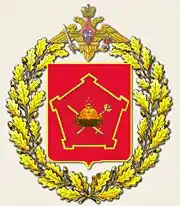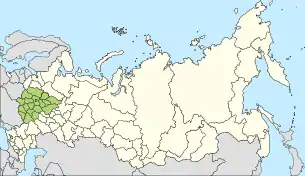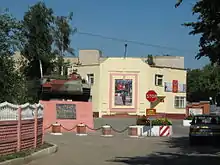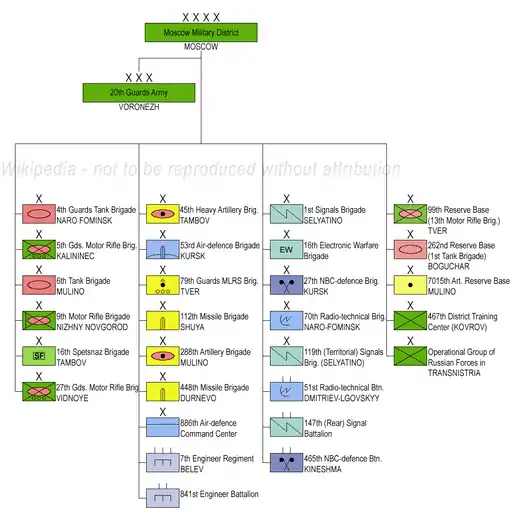Moscow Military District
The Moscow Military District was a military district of the Soviet Armed Forces and the Armed Forces of the Russian Federation. In 2010 it was merged with the Leningrad Military District, the Northern Fleet and the Baltic Fleet to form the new Western Military District.
| Moscow Military District | |
|---|---|
| Московский военный округ | |
 Moscow Military District Coat of Arms | |
| Founded | August 6, 1864 – 2010. |
| Country | |
| Branch | Russian Ground Forces |
| Type | Military district |
| Part of | Ministry of Defence |
| Headquarters | Moscow |
| Decorations | Order of Lenin |
History
In the beginning of the second half of the 19th century Russian officials realized the need for re-organization of the Imperial Russian Army to meet new circumstances.[1] During May 1862, the War Ministry, headed by Army General Dmitry Milyutin, introduced to Tsar Alexander II of Russia proposals for the reorganization of the army, which included the formation of fifteen military districts. A tsarist edict of 6 August 1864, announced in a Defence Minister’s order on 10 August of the same year, established ten military districts, including Moscow. The District’s territory then comprised 12 provinces: Vladimir, Vologda, Kaluga, Kostroma, Moscow, Nizhniy Novgorod, Ryazan, Smolensk, Tambov, Tver, Tula, and Yaroslavl. The District was intended as a reinforcement source for troops and equipment, being some distance from the frontier, rather than an operational area.
The District dispatched five infantry and a cavalry division south to the Russo-Turkish War of 1877–8, as well as sending another division to the Caucasus area. This force totaled around 30,000 men and 20,000 horses. Over 80,000 men were also called into reserve units. The District also housed 21,000 Turkish prisoners of war. During the First World War over a million men were stationed in the district. Much of the garrison was involved in the October Revolution of 1917, and consequent establishment of a Soviet regime in the cities of Bryansk, Vladimir, Voronezh, Kaluga, Nizhniy Novgorod, Orel, Tver, Yaroslavl. By a resolution of the Moscow military revolutionary committee on 17 November [O.S. 4 November] 1917, Corps Commander N.I. Muralov was assigned as the new commander of the district.
.jpg.webp)
In the period of the Russian Civil War and military intervention in Russia 1917 - 22 the District prepared military personnel for all the fronts and supplied the Red Army with different forms of armament and allowances. From June to the middle of September 1919 the District conducted 33 callups totalling more than 500,000 people. In Moscow the 1 Moscow Rifle Division, Warsaw revolutionary infantry regiment, and 2nd revolutionary infantry regiment were formed, and Latvian forces were brought to the Latvian Rifles Division. In Voronezh two cavalry divisions were formed, two rifle divisions and two rifle regiments in Nizhniy Novgorod, and the 16th Rifle Division in Tambov. Artillery units too were also being raised in the capital area.
After the end of Civil War in the troops of region were demobilized, as a result of which their number was reduced from 580,000 (at the end of 1920) to 85,000 in January 1923, and the District was reorganised on a peacetime basis. In the 1920s the District had 10 rifle divisions: the 1st Moscow Proletariat Red Banner Rifle Division (first formed either in December 1924 or at the beginning of 1927), the 6th Oryol; the 14th Vladimir; the 17th Nikhegorodskaya; the 18th Yaroslavskaya; the 19th Voronekhskaya; the 48th Tverskaya; the 55th Kurskaya; the 81st Kaluga; and the 84th Tula.[2] Autumn maneuvers began to be conducted yearly here in the district. The 2nd Rifle Corps was stationed in the district from 1922 to 1936. In the beginning of the 1930 tanks started to be introduced, including the MS or T-18, T-26, T-27, BT, T-28, and the heavy T-35. In 1930 the first mechanized infantry brigade in the Soviet Army was formed in the district.

The Russian Ground Forces' official site notes that the first tactical parachute landing took place in the District on 2 August 1930.
In World War II the District formed three fronts, 23 armies, 128 divisions of all arms, and 197 brigades of all arms, an approximate total of 4.5 million men. In 1944–5 alone the District sent to the front 1,200,000 soldiers. From summer 1945 to summer 1946, in order to supervise the demobilisation process, the District was subdivided into four: the Moscow, Voronezh (1949–60), Gorki (1945—1947, 1949—1953) (where the 324th Rifle Division was probably demobilised), and Smolensk Military Districts (33rd Army, home from Germany, formed Smolensk MD headquarters in late 1945). General Kirill Moskalenko took command of the District in 1953 and would later be a Marshal of the Soviet Union after leaving his post.
The Voronezh Military District was reactivated in 1949 and was active until 1960.
In 1955 the district's forces comprised the 1st Guards Rifle Corps, the 13th Guards Rifle Corps, the 3rd Guards Rifle Division, the 15th, the 31st Guards, the 38th Guards Rifle Divisions, the 4th Guards Kantemirovskaya Tank Division, the 23rd Guards, 65th, and 66th Guards Mechanised Divisions, the 71st Mechanised Division, and the 38th Guards Airborne Corps (105th Guards Vienna Airborne Division and 106th Guards Airborne Division).[3]
On 22 February 1968, for the large contribution to the cause of strengthening the defense of the state, for its successes in combat and political training, and in view of the 50th anniversary of the Soviet Army plus its important role in the 2nd World War, the District was awarded with the Order of Lenin.
In 1979 Scott and Scott reported the HQ address as being Moscow, A-252, Chapayevskiy Per., Dom 14.
The District's dispositions at the end of the 1980s were:[4]
- 13th Guards Army Corps, Gorkiy. In 1990 this corps was under the command of General Fyodor Reut.
- 60th Tank Division, Dzerzhinsk (former 60th Rifle Div., then briefly 65th Mech Div and 43rd Tank Div before becoming 60th Tank Div in 1965; disbanded 1990)[5]
- 206th Motor Rifle Division, Tambov (became a storage base 1989)
- District Troops
- 2nd Guards 'Taman' Motor Rifle Division, Kalinnets
- 4th Guards Kantemirovskaya Tank Division, Naro-Fominsk
- 26th Guards Tank Training Division, Vladimir
- 32nd Guards Motor Rifle Division, Kalinin ('Таманская краснознаменная, ордена Суворова') (became 5210 BAse for Storage of Weapons and Equipment in 10.1989, disbanded 1993)[6]
- 106th Guards Airborne Division, Tula
Also listed by Soldat.ru are the 196th Motor Rifle Division, Kursk, the 225th Motor Rifle Division at Mulino, the 228th Rear Defence Division in Moscow itself, 267th Spare Motor Rifle Division.
Commanders
Commanders (1864-1917)
- General of Infantry Alexander von Güldenstubbe; (August 10, 1864 - April 17, 1879)
- Adjutant General, General of the Cavalry Pontus Brevern-de la Gardie; (April 17, 1879 - August 30, 1888)
- Adjutant General, General of Artillery Apostol Kostanda; (August 1888 - May 1896)
- Adjutant General, Lieutenant General, Grand Duke Sergei Alexandrovich of Russia; (May 1896 - February 4, 1905)
- General of Infantry Nikolai Nikolayevich Malakhov; (February 1905 - January 1906)
- Lieutenant General Sergei Konstantinovich Gershelman; (January 15, 1906 - March 17, 1909)
- General of the cavalry Paul von Plehwe; (March 17, 1909 - July 19, 1914)
- General of Infantry Alexander G. Sandetsky; (July 1914 - May 1915)
- Adjutant General, Lieutenant General Prince Felix Felixovitch Soumarokov-Elston; (May 5, 1915 - June 19, 1915)
- General of Infantry Petr. D. Olkhovsky; (July 1915 - September 1915)
- General of Artillery Iosif Mrozovsky; (September 22, 1915 - March 1, 1917)
- Lieutenant Colonel Alexander E. Gruzinov (March 1917 - April 1917)
- Colonel Aleksander Verkhovsky (May 31, 1917 - August 30, 1917)
- Lieutenant Colonel Konstantin I. Ryabtsev (September 1917 - November 1917)
Commanders (1918–2010s)
- Nikolay Muralov, (November 1917 - February 1919)
- Sergey Natsarenus, (March 1919 - June 1919)
- Aleksandr Burdukov, (June 1919 - December 1920)
- Pavel Petryaev, (December 1920 - February 1921)
- Nikolay Muralov, (March 1921 - April 1924)
- Kliment Voroshilov, (April 1924 - November 1925)
- Georgy Bazilevich, (November 1925 - May 1927)
- Boris Shaposhnikov, (May 1927 - January 1928)
- Commandarm August Kork (1930–1935)
- Comcor Boris Gorbachyov (1935)
- Commandarm 1st Rank Ivan Belov (1935–1937)
- Marshal of the Soviet Union Semyon Budyonny (1937–1939)
- General of the Army Ivan Tyulenev (1939–1941)
- Colonel General Pavel Artemyev (1944–1947)
- Marshal of the Soviet Union Kirill Meretskov (1947–1949)
- Colonel General Pavel Artemyev (1949–June 1953)
- General of the Army Kirill Moskalenko (June 1953–October 1960)
- Мarshal of the Soviet Union Nikolay Krylov (October 1960–4 March 1963)
- General of the Army Afanasy Beloborodov (5 March 1963 – 1968)
- Colonel General Yevgeny Ivanovsky (1968–1972)
- Colonel General (promoted to General of the Army October 1977) Vladimir Govorov (1972–1980) (son of the Soviet Marshal Leonid Govorov)
- General of the Army Petr Lushev (1980–June 1985)
- Colonel General Vladimir Arkhipov (June 1985–August 1988)
- General of the Army Konstantin Kochetov (August 1988–May 1989)
- Colonel General Nikolai Kalinin (May 1989–September 1991)
- Lieutenant General Vladimir Toporov (September 1991–17 May 1992)
- Colonel General Leonid Kuznetsov (1992–1999)
- Colonel General Ivan Puzanov (1999–2001)
- Colonel General Nikolai Makarov (2001, acting)
- General of the Army Ivan Efremov (2001–2005)
- General of the Army Vladimir Bakin (2005–2009)
- Colonel General Valery Gerasimov (2009–2010)
Structure (1990s–2010s)

With the collapse of the USSR the District became for the first time in its history a boundary district and thus a new priority was put on building up combat forces within it, rather than the training and capital garrison focus of the Soviet period.
In the early 1990s the District received the headquarters of the First Guards Tank Army from the Group of Soviet Forces in Germany. It was relocated to Smolensk, and consisted of the 4th Guards Tank Division and 144th Guards Motor Rifle Division (at Yelnya). However the Army's headquarters disbanded later in the 1990s, along with the 144th Guards MRD. In addition, the 6th Guards Motor Rifle Brigade was withdrawn from Germany and restationed at Kursk.
The 22nd Army Headquarters was reformed from 13th Army Corps in the early 1990s, to control the new 3rd Motor Rifle Division among other formations. The 22nd Army had previously been inactive for a long period; it was last operational immediately after the war (when it participated in the Second Rzhev-Sychevka Offensive in late 1942) when its HQ along with the 109th Rifle Division arrived in the South Ukraine in May 1945. In the Northern summer of 1945, together with the headquarters of the Separate Coastal Army, located in the Crimea, it was reorganised as the new but short-lived Tavria Military District.
After several years as a direct reporting formation, the Operational Group of Russian Forces in Moldova was realigned under the command of the Moscow Military District in 1998.[7] Previously the 14th Guards Army (it was renamed in April 1995[8]), forces and individuals from this command played a major part in the early 1990s in establishing and maintaining the trans-Dnestr separatists of the Transnistria as a viable de facto state.
Order of battle c. 2006
The District had around 75,000 troops assigned and consisted of the following formations. The entire Ground Forces began to go through a major reorganisation (the 2008 Russian military reform), which apparently began in March 2009, in which armies are becoming operational commands and divisions are being redesignated brigades.
- Kremlin Presidential Regiment
- 2nd Tamanskaya Guards Motor Rifle Division
- 34th Guards Artillery Division, Mulino (Gorokhovets), гвардейская артиллерийская дивизия
- 27th Guards Sevastopol Motor Rifle Brigade, Teplyy Stan[9] мотострелковая бригада
- 112th Rocket Brigade (Shuya) (Tochka SSM)
- 20th Guards Army, 20-я армия (to operational command)
- 4th Guards Kantemirovskaya Tank Division, (to brigade)
- 10th Guards Uralsko-Lvovskaya Tank Division, гвардейская танковая Уральско-Львовская дивизия (to brigade)
- 397th MRL Regiment (Skopin)
- 448th Rocket Brigade (Kursk) (Tochka SSM)
- 4944th Base for Storage of Weapons and Equipment (Yelnya)(former 144 Guards MRD)
- other units
- 22nd Army, 22-я армия, Nizhni Novgorod (appears to be disbanding)
- 3rd Vislenskaya Motor Rifle Division, Mulino, мотострелковая Вислянская дивизия (splitting into two brigades)
- 5th Anti-Aircraft Rocket Brigade (Shuya)
- 50th Rocket Brigade (Shuya) (Tochka SSM)
- 211th Artillery Brigade (Mulino)
- 918th Multiple Rocket Launcher Regiment (Mulino)
- Base for Storage of Weapons and Equipment (Tver) (ex 166th Motor Rifle Brigade)
- other units
- Operational Group of Russian Forces in Moldova (Tiraspol) (formerly 14th Guards Army)
- (two?) separate battalions, formerly from the 8th Guards MR Brigade[10]
- 16th Spetsnaz Brigade, 16-я бригада спецназа
- 467th Guards District Training Centre (Kovrov) (included 44th Guards Tank Training Regiment, Vladimir)
- 16th Air Army
- other formations and units
In addition to normal units, the district was home at least until 2001 to the 11th Separate Cavalry Regiment (ru:11-й отдельный кавалерийский полк), a unit used for producing war films.[11] The unit was based at Kobyakovo.
Subordinate Units

Order of Lenin Moscow Military District 2010:
- Combat formations:
- 4th Guards Independent Tank Brigade "Kantemir", in Naro-Fominsk
- 5th Guards Independent Motor-Rifle Brigade "Taman", in Kalininec equipped with BTR[12]
- 6th Independent Tank Brigade "Chentokhovskaya", in Mulino[13]
- 9th Guards Independent Motor-Rifle Brigade, in Nizhny Novgorod equipped with BMP
- 16th Independent Spetsnaz Brigade, in (Tambov)
- 27th Guards Sevastopol Motor Rifle Brigade, in Vidnoye equipped with BMP[14]
- Operational Group of Russian Forces (in Transnistria)
- 99th Reserve Base (13th Independent Motor-Rifle Brigade), in Tver
- 262nd Reserve Base (1st Independent Tank Brigade), in Boguchar
- 467th Guards District Training Centre, in Kovrov
- Missile and Artillery formations:
- Air-defence formations:
- 53rd Air-defence Missile Brigade, in Kursk equipped with the Buk missile system
- 886th Air-defence Command Center
- Radar formations:
- 70th Independent Radio Technical Brigade, in Naro-Fominsk
- 51st Independent Radio Technical Battalion, in Dmitriev-Lgovskyy
- Engineering formations:
- 7th Independent Engineer Regiment, in Belev
- 841st Independent Engineer Battalion
- NBC-defence formations:
- Signal formations:
- 1st Signal Brigade "Sevastopol", in Selyatino
- 16th Independent Electronic Warfare Brigade
- 119th Signal Brigade, in Selyatino
- 147th Independent (Rear) Signal Battalion
Formations of the Airborne Forces, including the 98th Guards Airborne Division and 106th Guards Airborne Division "Tula", also are based within the District's boundaries, but report directly to VDV headquarters.
Army General Vladimir Bakin was the former chief of staff – first deputy commander-in-chief of forces of the Volga-Ural Military District.
Notes
- This section is translated from the official website of the District – http://www.mil.ru/848/1045/1272/1365/1362/1890/index.shtml Archived 2007-09-29 at the Wayback Machine
- Lenskii, 2001
- Feskov, 2004, p. 49
- Feskov, V.I.; K.A. Kalashnikov; V.I. Golikov (2004). The Soviet Army in the Years of the 'Cold War' (1945–1991). Tomsk: Tomsk University Press. ISBN 5-7511-1819-7.
- Feskov et al. 2004., 75.
- "32nd Guards Motorised Rifle Division". www.ww2.dk.
- Andrew Duncan, Russia and Ukraine: restructuring for a new era, Jane's Intelligence Review, June 1998, p.5
- RAND, CF 129, Chapter 4 Trans-Dniestria Archived 2007-08-04 at the Wayback Machine
- "27th independent Guards Motorised Rifle Brigade". www.ww2.dk.
- See 59th Guards Rifle Division for the history of this formation.
- "Archived copy". Archived from the original on 2011-07-21. Retrieved 2010-08-03.CS1 maint: archived copy as title (link).
- "Archived copy". Archived from the original on 2010-02-24. Retrieved 2010-04-16.CS1 maint: archived copy as title (link)
- http://www.rian.ru/defense_safety/20090509/170546432.html
- "Юридический портал. Пошаговые инструкции". www.osbro.ru.
References
- Kommersant-Vlast, 'Vys Rossiya Armia'. https://web.archive.org/web/20050309013355/http://www.kommersant.ru/k-vlast/get_page.asp?page_id=2005769-22.htm, 14 May 2002
- IISS Military Balance
- Harriet Fast Scott and William F Scott, The Armed Forces of the USSR, Westview Press, Boulder, Colorado, 1979.
Further reading
- Order of Lenin Moscow Military District, translation of Russian 'Ordena lenina moskovskii voennyi okrug' by Air Force Foreign Technology Division, 1973. Original publication Moscow: Voenizdat (Military Publishing House), 1971